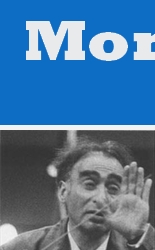Carl Maria von WEBER
Concerto pour clarinette No 1 en fa mineur, op. 73, J 114
Jos D'HONDT
Orchestre Philharmonique Néerlandais, Otto ACKERMANN
12.06.1954, MMS 198
Des trois oeuvres de Carl Maria von Weber pour clarinette et orchestre (deux concertos et un concertino), le concerto en fa mineur - composé en avril-mai 1811 - se distingue tant par sa puissance d'émotion que par sa belle ordonnance. C'est l'une des oeuvres romantiques incontournables pour la clarinette. Weber le compose - ainsi que ses autres oeuvres pour clarinette - pour son ami Heinrich Jos. Baermann, clarinettiste de la Chapelle Royale de Munich. La première audition a lieu le 13 juin 1811 à Munich, bien entendu avec Heinrich Baermann en soliste. Le numéro élevé d'opus - 79 - ne reflète pas la date de sa composition, mais résulte tout simplement de la publication tardive de l'oeuvre par Schlesinger (1822), qui l'ajouta tout simplement à la fin du catalogue.
Dans les concertos de Weber, le solo est mis en vedette, et finit même par empêcher l'orchestre d'évoluer librement. Le premier mouvement, dans sa forme habituelle, est traité sur le mode romantique: Son thème principal est énoncé par les deux passages de l'orchestre, tandis que le thème secondaire est confié au soliste. L'adagio, dont la partie centrale est plus animée que les deux autres, utilise le registre grave de la clarinette. Le rondo, extrêmement vif et brillant, clôt magnifiquement ce concerto.
La partition de l'oeuvre peut être téléchargée sur cette page de l'IMSLP, dans diverses éditions.
Dans l'enregistrement que je vous en propose le soliste est Jos D'HONDT, un splendide clarinettiste néerlandais hélas bien oublié, l'Orchestre Philharmonique Néerlandais (*) est dirigé par Otto ACKERMANN. L'enregistrement paraît sur la deuxième face du disque MMS 198 (avec la Pièce de concert, Op. 79, sur l'autre face, sous la direction de Victor DESARZENS, Lili KRAUS en soliste), puis est réédité sur l'album SMS 5215/16.
(*) Il s'agit d'un orchestre formé pour l'occasion, apparaissant très souvent dans les enregistrements Concert Hall & Sociétés affiliées, et non d'un précurseur de l'orchestre portant actuellement ce nom (Nederlands Philharmonisch Orkest), fondé bien plus tard, en 1985.
D'après cette page de Wikipedia c'est l'Orchestre Symphonique d'Utrecht (dont le chef à cette époque était Paul Hupperts) qui formait l'essentiel du «Netherlands Philharmonic Orchestra»..
D'après la discographie Ackermann de la Phonothèque Suisse il s'agit d'une prise de son du 12 juin 1954.
Un petit détail concernant le disque utilisé pour cette restauration: le sigle TU visible au bas de l'étiquette indique que la matrice de ce disque et le pressage ont été faits en Suisse par Turicaphon.
Voici donc...
Carl Maria von Weber, Klarinettenkonzert Nr. 1 f-Moll op. 73 J. 114, Jos D'Hondt, Netherlands Philharmonic Orchestra, Otto Ackermann, 12.06.1954, MMS 198
|
|
|
| 1. |
Allegro |
06:53 |
| 2. |
Adagio, ma non troppo |
04:59 |
| 3. |
Rondo. Allegretto |
06:23 |
|
|
|
que vous pouvez obtenir en...
pour un téléchargement libre, depuis mon site
Musical Masterpiece Society MMS 198 -> WAV -> léger à moyen DeClick avec ClickRepair (l'excellent logiciel de Brian Davies), des réparations manuelles -> FLAC
3 fichiers FLAC, 2 fichiers CUE (*) et 1 fichier PDF dans 1 fichier ZIP
(*) 1 fichier CUE pour les fichiers décomprimés en WAV et 1 fichier CUE pour les fichiers comprimés FLAC, si votre logiciel peut utiliser directement les fichiers FLAC.
note 1
Une intéressante courte description du concerto pour clarinette No 1 en fa mineur, op. 73, J 114, de Carl Maria von Weber, citée de cette page d'Hyperion, un extrait d'un texte de David Kettle, 2012:
"[...] After the piece’s initial performances, Bärmann felt that the first movement ought to show off his abilities to greater effect, so he inserted a short cadenza that functions like a flourish for the soloist.
Although it has contrasting themes, development, a cadenza and a form of recapitulation, the Concerto’s first movement is not strictly speaking in sonata form. Instead, the orchestra and soloist take a subject each. The cellos have the distinctive first subject, based around a rising and falling F minor triad, which explodes in towering tutti chords that come as if from nowhere. Following stormy outbursts from the orchestra, the soloist enters with a poignant second theme marked con duolo (‘sorrowfully’). After a return of the opening theme, this time in D-flat major and with embellishments from the soloist, a section featuring clarinet triplets leads to Bärmann’s cadenza. A development section combines earlier themes, and the brief recapitulation presents a restatement of the opening triad theme before the clarinet takes over in sparkling runs and the movement subsides into a ruminative conclusion.
In the second movement, the clarinet floats an aria-like melody over gently rocking chords in the strings. The movement’s middle section is in two parts, the first a brief but assertive C minor episode where the clarinet performs runs up and down over a wide range. The second is another of Weber’s dark-hued passages, combining the solo clarinet with a trio of horns in an exquisite chorale. A restatement of the opening melody and a brief reminiscence of the horn chorale end the movement.
The finale is a jaunty, dance-like rondo in 2/4, which the clarinet mischievously seems intent on slowing down on two occasions. It reaches a temporary conclusion with a brief flourish that sends the clarinet up into its highest register, but continues in an introspective episode in D minor, breathless semiquavers from the soloist in a B-flat major passage, and joyful final bars.[...]"
<retour>
note 2
Jos D'HONDT
Il y a quelques années radio4.nl avait publié une page avec quelques informations sur le clarinettiste Jos D'HONDT, une page qui n'est toutefois plus disponible. Par chance la traduction de Rolf Otter est encore disponible: par précaution je la cite ci-dessous.
"[...] For those who can't read Dutch...
Here is my English version:
Sometimes you find a record and you think, who was this player? Where did he came from... Well:
Jos d'Hondt was born in Antwerp, Belgium in 1907. Early on, he had a keen interest in music. Although he was a prodigy, from the hands of king Albert I he received a gold medal for his playing in 1926, his father insisted he should also learn a "proper job", and therefore simultaneously schooled him in the family business, tailoring... Jos d'Hondt replaced his teacher at the French opera in the Bourla theatre in Antwerp, but when this company was closed down in 1933, he followed Paul Godwin to the Netherlands, and played clarinet in his orchestra.
During the war, his ID (persoonsbewijs) indicating he was a "stranger", he went in to hiding in Amsterdam. After the war he met his, Dutch, wife, and stayed in the Netherlands, becoming the principal clarinetist at the Dutch Radio Philharmonic orchestra, then conducted by figures as Paul van Kempen and Bernard Haitink. During the next years, he became the most influential clarinet teacher in the Netherlands. There was hardly any orchestra in the Netherlands during the '60s and '70's that hadn't a Jos d'Hondt pupil in it's wind section. He was so involved in education, that when ever he went to the toilet, orchestra members would remark, "Jos is probably giving clarinet lessons again.... "
Among his students were George Pieterson (his nephew, Concertgebouworchestra), Leo van Tol (Limburg symphony orchestra) and Henk de Graaf (Rotterdam Philharmonic orchestra). Henk de Graaf remembers about his lessons with Jos d'Hondt:
In my first year at the Utrecht Conservatory, I entered in class of Jos d'Hondt. He was very strict and I had to unlearn certain things, like the way I played staccato. I always did it my own way, very rapid, and there was never anything said about it. Jos d'Hondt was able to pinpoint exactly what you had to do to sound the staccato right. He never educated scholastic, but in a good professional way. Most of the time he gave his lessons at home in Hilversum. That was the easy for him, so close to the Radio Philharmonic Orchestra where he was solo clarinet player. He taught at his attic and if you rang the doorbell in the morning, the first thing he always asked was, 'Have you studied well this week?' and if you then said 'Yes' and it was' No ', and then played lousy, you could go again... I never dared to say 'No', always said 'Yes', and then tried to make the best of it. Fortunately I was never send away.
He was often very direct in his verdict. For example, if I played an accent in the wrong place, he told me: 'Man, that must be quite different! " In the lessons he always demonstrated a phrase in a sublime way, I have learned a lot from that. Jos was someone I look up to. Once he gave a concert on television with the Radio Philharmonic Sextet - wind quintet and piano. I was waiting before the television for hours, that's how I looked upon him.
We always started a half hour long with scales. Everything from memory and in various ways such as: two bound, two striked, dom7 chords. Everything in the whole range of the clarinet until you reached the difficult sharp and flat notes came. After that came the etudes or scales of Jeanjean, Cavallini, Perier and Baermann. Then the elementary repertoire, with the same intention. It was always two hours of hard labour, but I never really dreaded those long lessons. Everything was perfect. When that was not the case, well, study a week at home then. He simply demanded that everything was ok at the end.
Jos d'hondt taught in the conservatories of Utrecht, Amsterdam and Tilburg. Just after he retired in 1973 he passed away...
Greetings,
Rolf [...]"
<retour>

